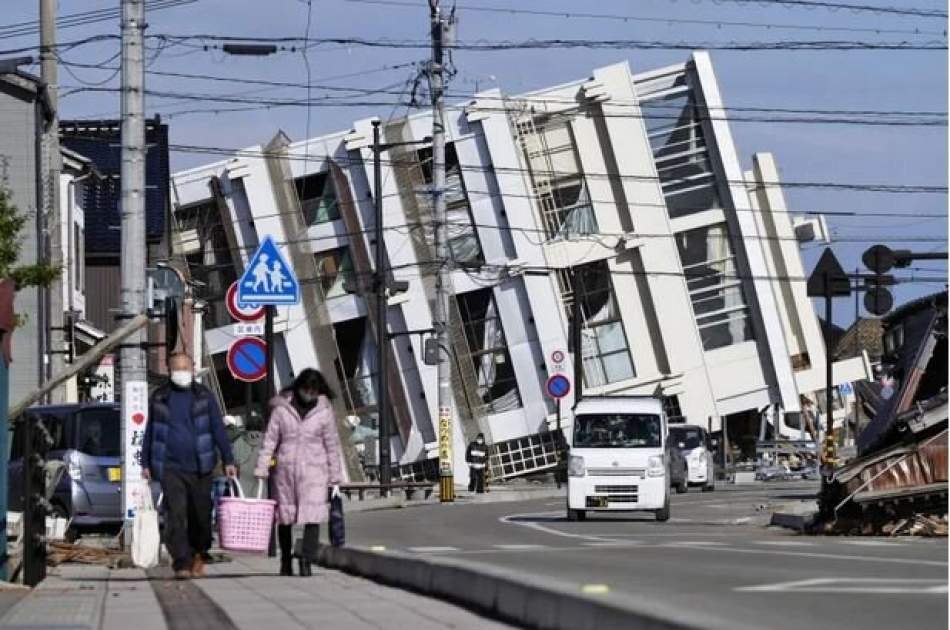The death toll from the powerful 7.6-magnitude earthquake that shook the Noto Peninsula on Monday afternoon has risen to 62, and authorities are scrambling to help survivors in sub-zero temperatures, freezing temperatures and heavy rain. are facing, continues.
Publish dateThursday 4 January 2024 - 09:47
Story Code : 283464
Afghan Voice Agency (AVA): Since the morning of Monday, January 1st, the western regions of Japan have faced more than 100 small or large earthquakes in the sea or coastal areas, and these earthquakes, in addition to casualties, have also led to heavy financial losses.
The Japan Meteorological Organization has predicted heavy rains in the earthquake-affected areas for today (Wednesday), which has added to the concerns of landslides and could face serious problems in efforts to rescue many people trapped under the rubble.
Damage to roads and infrastructure, especially in remote areas, has complicated relief efforts, and for this reason, the exact amount of damages and casualties is still unclear two days after the heavy earthquake.
This earthquake is Japan's deadliest earthquake since at least 2016, and smaller earthquakes continue to occur on the peninsula.
Japanese Prime Minister Fumio Kishida announced that in order to speed up rescue operations, the government has opened a special sea route for sending aid, so that some larger vehicles can now reach some of the most affected areas more quickly. reach.
At the same time, experts say: Monday's powerful earthquake in Ishikawa province may have moved the land in Noto region near its center by 1.3 meters to the west.
The Geospatial Information Agency of Japan, known as GSI, analyzed the GPS data following the earthquake.
The agency says preliminary figures show that an observation point in the city of Wajima in Ishikawa Prefecture saw the most displacement, moving horizontally about 1.3 meters to the west.
According to NHK, this analysis also shows a displacement of about one meter in the city of Anamizu and a displacement of 80 centimeters in the city of Suzu. An observation point in "Notojima" neighborhood of "Nanao" city was moved 60 cm to the northwest of the coast of the Sea of Japan.
According to Euronews, it also seems that the ground in Toyama and Niigata prefectures has moved about 20 centimeters to the northwest. Earth displacement of several centimeters has been observed in Kanto-Koshin region and other places.
GSI wants to continue analyzing data for other displacements as well.
The Japan Meteorological Organization has predicted heavy rains in the earthquake-affected areas for today (Wednesday), which has added to the concerns of landslides and could face serious problems in efforts to rescue many people trapped under the rubble.
Damage to roads and infrastructure, especially in remote areas, has complicated relief efforts, and for this reason, the exact amount of damages and casualties is still unclear two days after the heavy earthquake.
This earthquake is Japan's deadliest earthquake since at least 2016, and smaller earthquakes continue to occur on the peninsula.
Japanese Prime Minister Fumio Kishida announced that in order to speed up rescue operations, the government has opened a special sea route for sending aid, so that some larger vehicles can now reach some of the most affected areas more quickly. reach.
At the same time, experts say: Monday's powerful earthquake in Ishikawa province may have moved the land in Noto region near its center by 1.3 meters to the west.
The Geospatial Information Agency of Japan, known as GSI, analyzed the GPS data following the earthquake.
The agency says preliminary figures show that an observation point in the city of Wajima in Ishikawa Prefecture saw the most displacement, moving horizontally about 1.3 meters to the west.
According to NHK, this analysis also shows a displacement of about one meter in the city of Anamizu and a displacement of 80 centimeters in the city of Suzu. An observation point in "Notojima" neighborhood of "Nanao" city was moved 60 cm to the northwest of the coast of the Sea of Japan.
According to Euronews, it also seems that the ground in Toyama and Niigata prefectures has moved about 20 centimeters to the northwest. Earth displacement of several centimeters has been observed in Kanto-Koshin region and other places.
GSI wants to continue analyzing data for other displacements as well.
avapress.net/vdcg3w9xtak97t4.5jra.html
Tags
Top hits







